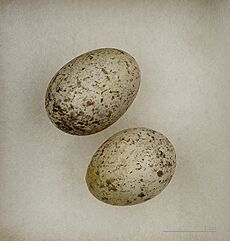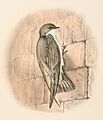Pale crag martin facts for kids
Quick facts for kids Pale crag martin |
|
|---|---|
 |
|
| Pale crag martin flying in the Eastern Desert, Southern Egypt. | |
| Conservation status | |
| Scientific classification | |
| Genus: |
Ptyonoprogne
|
| Species: |
obsoleta
|
 |
|
|
Approximate range
|
|
The pale crag martin (Ptyonoprogne obsoleta) is a small passerine bird from the swallow family. It lives in parts of Northern Africa and Southwestern Asia, reaching as far east as Pakistan. These birds mostly live in mountains. But you can also find them in rocky areas and towns, even far from water, which is unusual for swallows.
This martin is about 12 to 13 centimeters (5 inches) long. It has mostly brown plumage (feathers). Its upper chest and underwing feathers are lighter brown. When it flies, you can see white "windows" on its spread tail. Male and female pale crag martins look alike. Young birds have pale edges on their upper feathers and flight feathers. This bird used to be thought of as a northern type of the rock martin. However, it is smaller, paler, and has a whiter throat. The pale crag martin flies slowly, gliding a lot, as it hunts flying insects along cliff faces. Its call is a soft twittering sound.
This martin builds a deep, cup-shaped nest. It places the nest on sheltered flat surfaces or against vertical rock faces or walls. The nest is made from mud pellets and lined with grass or feathers. They often build nests in natural spots like under cliff overhangs. They also use human-made places like buildings and bridges. Martins often reuse their nests for new broods or in later years. These birds usually nest alone. However, small groups might nest close together if there are good spots. A typical nest has two or three white eggs with brown and grey spots. Both parents sit on the eggs for 16 to 19 days until they hatch. Then, both parents feed the chicks. The young birds learn to fly in another 22 to 24 days. After their first flight, they may return to the nest to sleep for a few more days.
Fast-flying falcons, like hobbies, sometimes catch pale crag martins. These birds can also have parasites. But overall, they do not face major threats. The pale crag martin lives across a huge area, almost 20 million square kilometers (7.7 million square miles). Its population is large and seems to be growing. Because of this, it is not considered at risk. The IUCN Red List lists it as a species of Least Concern.
Contents
About the Pale Crag Martin
The pale crag martin was first officially described in 1851. A German bird expert named Jean Cabanis gave it the name Cotyle obsoleta. He studied a bird found near Cairo, Egypt. Later that year, another German bird expert, Heinrich Gustav Reichenbach, moved it to a new group called Ptyonoprogne. The name Ptyonoprogne comes from ancient Greek words. Ptuon means "a fan," referring to the bird's tail when it's open. Procne is a mythological girl who turned into a swallow. The second part of its scientific name, obsoleta, means "worn" in Latin.
The Ptyonoprogne species are part of the swallow family. They belong to a subgroup called Hirundininae. This group includes all swallows and martins, except for the unique river martins. Studies of bird DNA sequences show that swallows and martins can be grouped by the type of nest they build. The Ptyonoprogne species build open nests made of mud. This puts them in the "mud nest builders" group.
The pale crag martin is closely related to other birds in its group. These include the dusky crag martin of southern Asia, the rock martin of Southern Africa, and the Eurasian crag martin. The pale crag martin was once thought to be a smaller, paler northern type of the rock martin. But now, it is usually seen as its own separate species.
What the Pale Crag Martin Looks Like
The pale crag martin of the main type, P. o. obsoleta, is about 12 to 13 centimeters (5 inches) long. Its upper parts are light brown. The color becomes paler on its lower back. Its short, square tail has small white patches near the tips of most feathers. Only the very middle and outer feathers don't have these patches. It has a pale grey throat, upper chest, and underwing feathers. The rest of its underparts are a dirty white color. Its eyes are brown, its small beak is mostly black, and its legs are brownish-pink. On average, its wings are about 13 centimeters (5 inches) long, and its tail is about 4.8 centimeters (2 inches) long. Male and female birds look similar. Young birds have pale edges on their upper feathers and flight feathers.
This martin changes its feathers (moults) early. Adult birds have all new feathers by late August. Young birds moult a bit later. Their old primary flight feathers stay even when most of their body feathers are new.
The pale crag martin flies slowly. It has quick wing beats mixed with flat-winged glides. It is more agile than the larger Eurasian crag martin. It is a quiet bird. Its song is a soft, muffled twitter. Other calls include a "trrt" sound, a nasal "vick," and a high-pitched "twee" contact call.
The pale crag martin is duller in color than most African swallows. It is unlikely to be confused with other birds, except for other crag martins or sand martins. It is 15% smaller, paler, and greyer than the Eurasian crag martin. It also has smaller white spots on its tail. It is smaller, paler, and has a throat that stands out more than the rock martin. In the far east of its range, the pale crag martin always has lighter underparts than the dusky crag martin.
Where Pale Crag Martins Live

The pale crag martin lives in suitable places across northern Africa and the Middle East, reaching Afghanistan and Pakistan. They mostly stay in one area. Sometimes they move locally or go to lower altitudes after breeding. Martins from southern Arabia might cross the Red Sea to spend winter in Ethiopia and the Horn of Africa.
These birds naturally live in hilly or mountainous areas with cliffs, gorges, and caves. They can be found up to 3,700 meters (12,000 feet) above sea level. But this martin also lives in lowlands, especially if there are rocks or buildings. They can even be found far from water. This species easily uses human-made structures instead of natural cliffs. For example, they have nested on houses in southern Israel since the 1970s. In Egypt, they might nest near ancient monuments like Abu Simbel or in desert towns such as Aswan. They use towns, bridges, and cliffs in Ethiopia. In Arabia, they use tower blocks. During breeding season, they need mud or wet soil to build their nests. This is usually easy to find near human homes.
Pale Crag Martin Behavior
Reproduction and Nesting
Pale crag martin pairs often nest alone, especially in the Sahara desert. But if there are many good spots, small groups might form loose colonies. This martin strongly protects its nesting area from other birds of its own kind and other species. In Africa, breeding times change depending on the area and local weather. But in northwest Africa, they usually breed from February to April. In Asia, nesting is from April to June. It's common for them to have two sets of chicks (broods), and sometimes even three in one season.
Both adult birds build the nest over several weeks. It is made from hundreds of mud pellets. They line it with feathers and soft, dry grass, hair, sheep's wool, or plant down. The nest might be a half-cup shape if built under an overhang on a vertical wall or cliff. It can also be shaped like a bowl, similar to a barn swallow's nest, if placed on a sheltered ledge. The nest can be on a rock cliff, in a crack, or on a human-made structure. They reuse the nest for the second brood and in following years. Caves are often found in limestone and lava areas. Their ceilings are a favorite spot for nesting pale crag martins. In buildings, nests are usually built against concrete. This surface is similar to rock and helps the nest stick. Sometimes, they use metal walls or build nests on beams. Birds sometimes nest in buildings where people live. There's even a story of a pair nesting in a busy restaurant kitchen! Artificial nests are also used. Halved coconut shells have been successfully used in Abu Dhabi.
A typical nest usually has two or three buff-white eggs. They have brown or grey-brown spots, especially at the wider end. For birds in Asia, the average egg size was 19.3 by 12.9 millimeters (0.76 by 0.51 inches). Each egg weighed about 1.7 grams (0.06 ounces). Both adult birds sit on the eggs for 16 to 19 days until they hatch. They feed the chicks about ten times an hour until they can fledge (fly). They continue feeding them for several days after their first flight. The time it takes for chicks to fledge can be 22 to 24 days, or sometimes 25 to 30 days. The longer estimates probably include young birds returning to the nest for food. If a nest is destroyed or the breeding fails, the parents might lay another set of eggs. This new set usually has fewer eggs. Two nests in Arabia were used in spring and again in autumn. But it's not known if the same pair of birds used them both times.
Feeding Habits
The pale crag martin mostly eats insects it catches while flying. But sometimes, it will eat insects on the ground. Breeding birds often hunt close to their nesting area. They fly back and forth along a rock face, catching insects with their beaks. Cliff faces create air currents that gather insects near vertical areas. Crag martins use these areas near cliffs to hunt. They are very good at flying and turning quickly. When they are not breeding, they might also hunt low over open ground. The insects they catch depend on what is available. This can include mosquitoes, flies, Hymenoptera (like wasps and bees), ants, and beetles. This martin often hunts alone. But large groups can gather at grass fires to eat insects trying to escape. Outside the breeding season, flocks of up to 300 birds might form where there is lots of food. This includes places like farms, wetlands, and sewage treatment plants. The pale crag martin drinks while flying. It skims the water surface to get a drink. It also gets some water from the insects it eats. Other swallows and martins that spend winter in the area usually don't live in the dry, rocky places where the pale crag martin nests. So, there isn't much competition for food.
Threats and Health
Some falcons are fast and agile enough to catch swallows and martins in flight. Pale crag martins might be hunted by birds like the peregrine falcon, Taita falcon, African hobby, and the Eurasian hobby (which spends winter in the area). Pale crag martins often share their nesting sites with little swifts. Sometimes, these swifts forcefully take over the martins' nests.
A type of tick called Hyalomma marginatum was found in pale crag martin nests in Egypt. This tick has been linked to spreading the Bahig virus. This virus was once thought to be spread only by mosquitoes. Another type of tick, Argas africolumbae, was found in a nest of the closely related rock martins in Kenya. A nasal mite called Ptilonyssus echinatus was found in a pale crag martin in northern Chad.
Conservation Status
The pale crag martin lives across a very large area, about 19.8 million square kilometers (7.6 million square miles). We don't know the exact total number of birds. But it is described as very common in Jordan and common in Egypt. Its range is growing, and its population is increasing. Because it lives in such a large area and likely has high numbers, the pale crag martin is not considered threatened. It is listed as Least Concern on the IUCN Red List.
This species is common in some parts of Algeria, but rare in Morocco and Pakistan. It has started nesting in southern Israel on houses since the 1970s. Large numbers can be found outside the breeding season in Saudi Arabia and Oman. Estimates suggest there are 10,000 to 100,000 pairs breeding in Egypt. There are 10,000 pairs in the United Arab Emirates. In Arabia, the winter population can be up to 150,000 birds. These birds sometimes form flocks of 300 to 500 birds. The pale crag martin has expanded its breeding range in the Arabian Peninsula. This has been helped by using tall buildings as nesting sites. More insects from farmland might also be helping. Breeding is now regular in Abu Dhabi. Tall buildings in Qatar might be the next place they start nesting. The pale crag martin first bred in Iraq in 2009.
Images for kids





